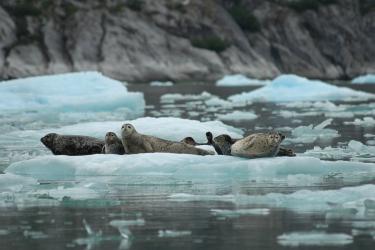Foreign Fishery Monitoring
1923
The International Pacific Halibut Commission is founded at the conclusion of the first convention, consisting of members representing both the United States and Canada, to assist in managing the Pacific halibut fishery.
1933
Japan starts a fishery for yellowfin sole in the eastern Bering Sea.
1941
The outbreak of World War II ends the yellowfin sole fishery.
1953
The Convention Between The United States and Canada For The Preservation Of The Halibut Fishery Of The Northern Pacific Ocean And Bering Sea signed in Ottawa, Ontario on March 2, 1953.
1954
Japanese fishing vessels return to the Bering Sea.
1959
Fishing vessels from the former U.S.S.R. join the Japanese.
Early 1960s
Participating vessels increase and target other species, mainly flatfish, and explore new fishing areas.
Mid 1960s
Japan and Russia target walleye pollock after a decline in flatfish stocks.
Late 1960s–1970s
Vessels from Taiwan, the Republic of Korea, and Poland fish in the eastern Bering Sea.
1973
The NOAA Fisheries places observers on foreign fishing vessels off the northwest and Alaskan coasts of the United States. This creates the North Pacific Foreign Fisheries Observer Program. Initially, observers were placed on vessels only by invitation from host countries. In the early years of the program, the primary purposes of observers were to find incidental catch rates of Pacific halibut in groundfish catches and to verify catch statistics in the Japanese crab fishery. Later, observers collected data on the incidence of king crab, snow (Tanner) crab, and Pacific salmon, and obtained biological data on other important species.
1976
The Magnuson-Stevens Fishery Conservation and Management Act mandates that foreign vessels accept observers.
1978
Americans fish for groundfish in joint ventures with foreign processing vessels.
1986
All non-joint ventures stop at this point. (See Below: Fishery observers placed on domestic vessels to support an industry-funded data gathering program.)
1991
All foreign fishing within the 200 mile Exclusive Economic Zone (EEZ) of the Bering Sea and Gulf of Alaska ends.
Domestic Fishery
1982
Congress enacts the Northern Pacific Halibut Act of 1982 based on the outcomes of the 1979 International Pacific Halibut Commission Convention Protocol Amending the Convention and the Magnuson-Stevens Fishery Conservation and Management Act.
1986
NOAA Fisheries places observers on domestic vessels to support an industry-funded data gathering program. This program was on domestic vessels fishing in the Bering Sea, north of Port Moller, where bycatch of red king crab was of concern.
Late 1980s
Other small-scale domestic observer programs start.
1988
Amendments to the Marine Mammal Protection Act (MMPA) require fishery vessels that have frequent interactions with marine mammals to carry observers for 20 to 30 percent of their fishing days.
1989
NOAA Fisheries places observers aboard vessels through Federal funding. The groundfish management plans for the Gulf of Alaska and eastern Bering Sea amend to establish mandatory observer coverage requirements for vessels and plants involved in the groundfish fishery in these areas.
1990
The North Pacific Observer Program begins. Under this program, NOAA Fisheries provides the operational oversight of the program, certification training, definition of observer sampling duties and methods, debriefing of observers, and management of the data. Although the vessel and plant owners pay for the cost of the observers, the Federal Government covers the costs associated with managing the program.
1996
The Sustainable Fisheries Act of 1996 enacted numerous science, management, and conservation mandates. It recognized the importance of healthy habitat for commercial and recreational fisheries. Fish and other marine species depend on their habitat to survive and reproduce.
Mid-1990s
The Alaska At-Sea Scales Program is developed in the mid-1990s to provide catch accounting methods for vessels, that were more precise and verifiable and less dependent on estimates generated by at-sea observers. Improved catch estimation was necessary because of the implementation of large-scale catch share programs. Catch share programs require NOAA Fisheries to provide verifiable and precise estimates of quota harvest.
2002
Essential Fish Habitat definition updates allow fishery management councils to designate Habitat Areas of Particular Concern, specific areas within EFH that have extremely important ecological functions and/or are especially vulnerable to degradation.
2011
Amendment 91 attempts to address bycatch of Chinook Salmon in the Bering Sea and Aleutian Island Management Area.
2012
Amendment 93 classifies Chinook Salmon as a Prohibited Species Catch (PSC) in the Central and Western Gulf of Alaska Management Area.
2013
NOAA Fisheries changes how observers in the partial coverage category deploy, how observer coverage in the partial coverage category is funded, and the vessels and processors that must have some or all of their operations observed. These changes increase the statistical reliability of data collected by the program, address cost inequality among fishery participants, and expand observer coverage to unobserved fisheries.
2015
Amendment 97 limits Chinook salmon prohibited species catch in Western and Central Gulf of Alaska non-pollock trawl catcher/processor and catcher vessel fisheries.
2018
NOAA Fisheries approves Amendment 115 for Groundfish of the Bering Sea and Aleutian Islands Management Area, Amendment 105 to the FMP for Groundfish of the Gulf of Alaska, Amendment 49 to the FMP for Bering Sea/Aleutian Islands King and Tanner Crabs, Amendment 13 to the FMP for the Salmon Fisheries in the EEZ Off Alaska, and Amendment 2 to the FMP for Fish Resources of the Arctic Management Area. These amendments revise the FMPs by updating the description and identification of essential fish habitat, and updating information on adverse impacts to EFH based on the best scientific information available.
NOAA Fisheries developed regulations to allow small fixed gear vessels in partial coverage to opt into the Electronic Monitoring (EM) selection pool for the calendar year rather than carrying an observer. The data collected from this coverage is used to obtain catch and discard information from these vessels. More information can be found in final rule to integrate electronic monitoring into the North Pacific Observer Program.
Electronic Monitoring is currently being used as a compliance monitoring tool in several catch share programs in Alaska.



